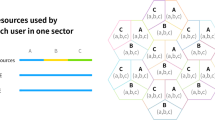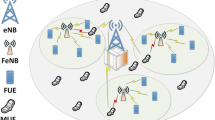Abstract
Nowadays small cells have become the integral part of 5G wireless communication network (WCN). However, the incorporation of small cells in 5G WCN creates chances for attackers to intrude into the network and this makes the network highly susceptible to attacks. Among various possible attacks, denial of service (DoS) attack is one of the most common network security attacks, and hence in this paper we consider a bandwidth spoofing attack which is a type of DoS attack that is carried out by an attacker during the communication between a macro base station and a small cell base station in a 5G WCN. We then propose a Bayesian game model to capture the interactions between the attacker and the network defender under the bandwidth spoofing attack and obtain the best strategies for defending the DoS attack. Further, since the DoS attack entails unavailability of the network, we address this issue by developing an availability model of the 5G WCN based on a stochastic reward net. Numerical results are presented which give insights into how the availability is affected by the DoS attack. The proposed model is also validated via simulation.









Similar content being viewed by others
References
Zou, Y. (2018). Intelligent interference exploitation for heterogeneous cellular networks against eavesdropping. IEEE Journal on Selected Areas in Communications, 36(7), 1453–1464.
Gupta, A., Jha, R. K., & Gandotra, P. (2018). Bandwidth spoofing and intrusion detection system for multistage 5G wireless communication network. IEEE Transactions on Vehicular Technology, 67(1), 628–632.
Xiao, K., Li, W., Kodoch, M., & Li, C. (2018). On the secrecy capacity of 5G mmWave small cell networks. IEEE Wireless Communications, 23(4), 47–51.
Rappaport, T. S., Xing, Y., MacCartney, G. R., Molisch, A. F., Mellios, E., & Zhang, J. (2017). Overview of millimeter wave communications for fifth-generation (5G) wireless networks—With a focus on propagation models. IEEE Transactions on Antenna and Propagation, 65(12), 6213–6230.
Zou, Y., Sun, M., Zhu, J., & Guo, H. (2018). Security—Reliability trade-off for distributed antenna systems in heterogeneous cellular networks. IEEE Transactions on Wireless Communications, 17(12), 8444–8456.
Gandotra, P., & Jha, R. K. (2017). A survey on green communication and security challenges in 5G wireless communication networks. Journal of Network and Computer Applications, 96, 39–61.
Ye, Q., Al-Salash, M., Caramanis, C., & Andrews, J. G. (2015). Distributed resource allocation in device-to-device enhanced cellular networks. IEEE Transactions on Communications, 63(2), 441–454.
Ferrag, M. A., Maglaras, L., Argyriou, A., Kosmanos, D., & Janicke, H. (2018). Security for 4G and 5G cellular networks: A survey of existing authentication and privacy-preserving schemes. Journal of Network and Computer Applications, 101, 55–82.
Wu, Y., Khisti, A., Xiao, C., & Wong, K.-K. (2018). A survey of physical layer security techniques for 5G wireless networks and challenges ahead. IEEE Journal on Selected Areas in Communications, 36(4), 679–695.
Fang, D., Qian, Y., & Hu, R. Q. (2017). Security for 5G mobile wireless networks. IEEE Access, 6, 4850–4874.
Fang, D., Qian, Y., & Hu, R. Q. (2019). Security analysis for interference management in heterogeneous networks. Ad Hoc Networks, 84, 1–8.
Zhao, N., Yu, F. R., Li, M., Yan, Q., & Leung, V. C. M. (2016). Physical layer security issues in interference—alignment-based wireless networks. IEEE Communications Magazine, 54(8), 162–168.
Guo, J., Zhao, N., Yu, F. R., Liu, X., & Leung, V. C. M. (2017). Exploiting adversarial jamming signals for energy harvesting in interference networks. IEEE Transactions on Wireless Communications, 16(2), 1267–1280.
Cheng, F., Gui, G., Zhao, N., Chen, Y., Tang, J., & Sari, H. (2019). UAV relaying assisted secure transmission with caching. IEEE Transactions on Communications, 67(5), 3140–3153.
Geva, M., Herberg, A., & Gev, Y. (2014). Bandwidth distributed denial of service. IEEE Security & Privacy, 12(1), 54–61.
Siddiqui, F., Zeadally, S., & Fowler, S. (2013). Broadband wireless technologies. In N. Chilamkurti, et al. (Eds.), Next generation wireless technology: 4G and beyond (pp. 71–103). London: Springer.
Liu, Y., Comaniciu, C., & Man, H. (2006). A Bayesian game approach for intrusion detection in wireless ad hoc networks. In GameNets’06, October 14, 2016, Pisa, Italy.
Zhou, C. V., Leckie, C., & Karunasekera, S. (2010). A survey of coordinated attacks and collaborative intrusion detection. Computers & Security, 29, 124–140.
Hunt, R., & Zeadally, S. (2012). Network forensics: An analysis techniques, tools, and trends. IEEE Computer, 45(12), 36–43.
Ramki, A. A., Rasoolzadegan, A., & Jafari, A. J. (2018). A systematic view on intrusion detection based on the hidden Markov model. Statistical Analysis and Data Mining, 11, 111–134.
Sahner, R. A., Trivedi, K. S., & Puliafito, A. (1996). Performance and reliability analysis of computer systems: An example based approach using sharpe software package. Boston, MA: Kluwer Academic Publishers.
Fudenberg, D., & Tirole, J. (1991). Game theory. Cambridge, MA: The MIT Press.
Thomas, R. W., Komali, R. S., Borghetti, B. J., & Mahonen, P. (2010). A Bayesian game analysis of emulation attacks in dynamic spectrum access networks. In IEEE symposium on new frontiers in dynamic spectrum (DySPAN), Singapore.
Subba, B., Biswas, S., & Karmakar, S. (2018). A game theory based multi layered intrusion detection framework for wireless sensor networks. International Journal of Wireless Information Networks, 25(4), 399–421.
Tadelis, S. (2013). Game theory. Princeton, NJ: Princeton University Press.
Bosch, P., Brusilovsky, A., McLellan, R., Mullender, S., & Polakos, P. (2009). Secure base stations. Bell Labs Technical Journal, 13(4), 227–243.
Trivedi, K. (2001). Probability and statistics with reliability, queuing and computer science applications (2nd ed.). New York: Wiley.
Muppala, J. K., Ciardo, G., & Trivedi, K. S. (1994). Stochastic reward nets for reliability prediction. Communications in Reliability, Maintainability and Serviceability, 1(2), 9–20.
Ge, X., Cheng, H., Guizani, M., & Han, T. (2014). 5G wireless backhaul networks: Challenges and research advances. IEEE Network, 28(6), 6–11.
Avizienis, A., Laprie, J. C., & Randell, B. (2000). Fundamental concepts of dependability. In Proceedings of the 3rd IEEE information survivability workshop (pp. 7–12).
Gupta, V., Dharmaraja, S., & Gong, M. (2011). Analytical modeling of TCP flows in wireless LANs. Mathematical and Computer Modelling, 63, 684–693.
Acknowledgements
One of the authors (K. C. Lalropuia) is grateful to the University Grant Commission (UGC), India, for granting him financial support through the CSIR-UGC Junior Research Fellowship (UGC-Ref. No.: 1031)
Author information
Authors and Affiliations
Corresponding author
Additional information
Publisher's Note
Springer Nature remains neutral with regard to jurisdictional claims in published maps and institutional affiliations.
Rights and permissions
About this article
Cite this article
Lalropuia, K.C., Gupta, V. A Bayesian game model and network availability model for small cells under denial of service (DoS) attack in 5G wireless communication network. Wireless Netw 26, 557–572 (2020). https://doi.org/10.1007/s11276-019-02163-8
Published:
Issue Date:
DOI: https://doi.org/10.1007/s11276-019-02163-8




